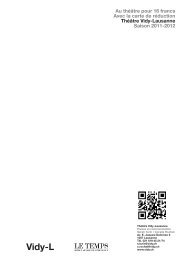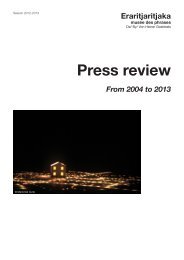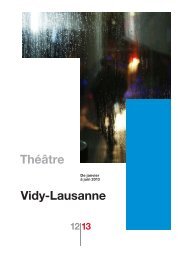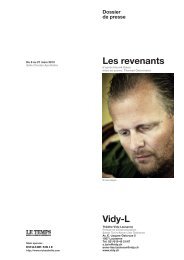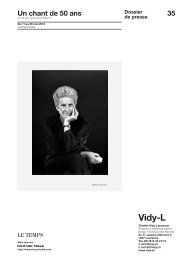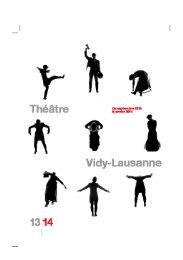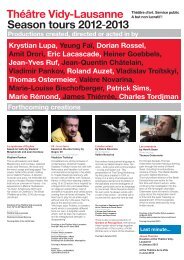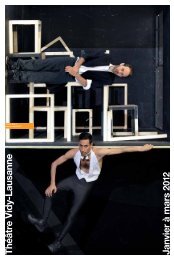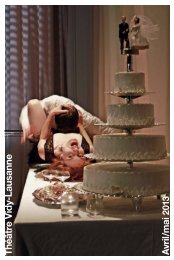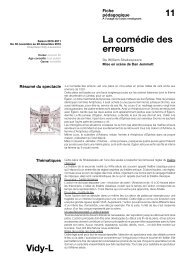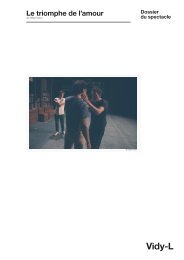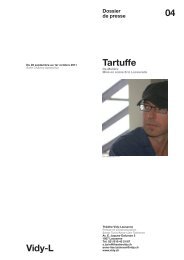Hashirigaki - Théâtre Vidy Lausanne
Hashirigaki - Théâtre Vidy Lausanne
Hashirigaki - Théâtre Vidy Lausanne
- No tags were found...
You also want an ePaper? Increase the reach of your titles
YUMPU automatically turns print PDFs into web optimized ePapers that Google loves.
Saison 2011-2012<strong>Hashirigaki</strong>De/ By/ Von Heiner GoebbelsNew York Times (EN)21.03.2003True Fluency In a Language Newly MadePredictably, perhaps 20 minutes into«<strong>Hashirigaki</strong>,» Heiner Goebbels’s delectablymystifying theatrical tone poem,a couple of dozen people, evidentlybefuddled and impatient, left the HarveyTheater at the Brooklyn Academy ofMusic on Wednesday night. Too bad forthem.Granted, the 90-minute work submergesan audience in an exotic pool of music,image and text that is certainly withoutthe life raft of literal meaning that sometheatergoers need to keep their interestafloat. But if you are willing to beseduced, the bewitching and breathtakinglyeclectic spirit of the show, whichruns through Sunday, can make you feelfluent in a new language.The Japanese word hashirigaki refersboth to a flowing, cursive script and tothe idea of talking while walking; theword suggests a forward motion on theone hand and the attempt to capture amoment on the other. And though theshow has no plot in the conventionalsense, it does render abstractly - andwith great beauty - this conflict betweenlife’s evanescence and the natural humanyearning to give it some kind ofconcrete meaning. And it does build toa kind of sweetly melancholy climax ofresignation.In this service, Mr. Goebbels has braidedtheatrical elements from several culturesand decades to create a pulsing, undulatingstream of sounds and images.The most well-publicized of these arethe show’s text, which comes from GertrudeStein’s seminally modernist epic,«The Making of Americans» (which Steincompleted in 1911 though it wasn’t publisheduntil 1925), and is delivered infitful snippets by the show’s three performers;and part of the score, for whichMr. Goebbels has appropriated fivesongs written by Brian Wilson for the1966 Beach Boysalbum, «Pet Sounds.»These sources would seem so culturallydisparate as to be random, but the couplingis crafty and meaningful. Stein’smammoth novel is about four generationsof a family, but what interests Mr.Goebbels is its passages of purposefullystylized prose, which employ limited vocabulary,uncustomary sentence structureand incantatory repetitions to createa sense of what the novelist and criticWilliam H. Gass calls the «progressivepresent.» A typical example: «Certainlyvery many come together to see something,to hear something, to do something,to see some see something, tosee some hear something, to hear somehear something, to feel something . . . «Similarly, the music of the Beach Boys,with the insistent, lurching rhythms anddroning harmonics that are redolent ofthe ocean, is equally suggestive of theexistential paradox of moving forwardand standing still.But the Beach Boys and Gertrude Steinactually constitute only a small part ofthe overall aesthetic of «<strong>Hashirigaki</strong>.»The show is a hypnotic collage of effects,with Mr. Goebbels orchestratingthe striking work of his designers. Theset and lighting designer Klaus Grünberg,working largely against a concavebackdrop, makes a series of lusciouslyevocative stage pictures punctuated byspectacular effects, like the Cy Twombly-esquescribbles of light that seem tofill up three dimensions on the stage.Two-thirds of the way through, the performersseem to build an Americantown on the stage using cardboard cutouts,complete with an automobile, achurch and a courthouse. Behind it, thebackdrop shows a vast, vague mountainscapeagainst the sky depicted ingloriously colored, modulating daylight.Weighted bells drop from the rafters onbungeecords and hang in the air, pendulously,like blimps. It’s intensely lovely.The costumes of Florence von Gerkan- in one solo ballet, the dancer is swaddledin a silvery, cellophanelike cocoon- make especially humorous use of thesize differences in the elegantly wittyperformers, one of whom is tiny (YumikoTanaka), one a half-foot taller (MarieGoyette) and one a half-foot taller again(Charlotte Engelkes). And the sound, byWilli Bopp, is as haunting as it is eclectic.For one thing, the actresses are of differentnationalities - Japanese, Canadianand Swedish, respectively - and their differentlyaccented English becomes partof the score. For another, much of theshow’s original music, by Mr. Goebbels,is in an Asian mode. And it is played bythe performers on various instruments:stringed, like the traditional Japanesekoto and samisen; electronic, like thetheremin, the sound machine that specializesin spooky wah-wah effects; keyboarded,like the harmonium (a sort ofpump organ); and percussive, from thehanging bells and an earthbound gongto finger cymbals and castanets.It is also pertinent that Mr. Goebbels isnot afraid of quietude. In this enthrallingwork of performance art, the language isheard.Bruce Weber



